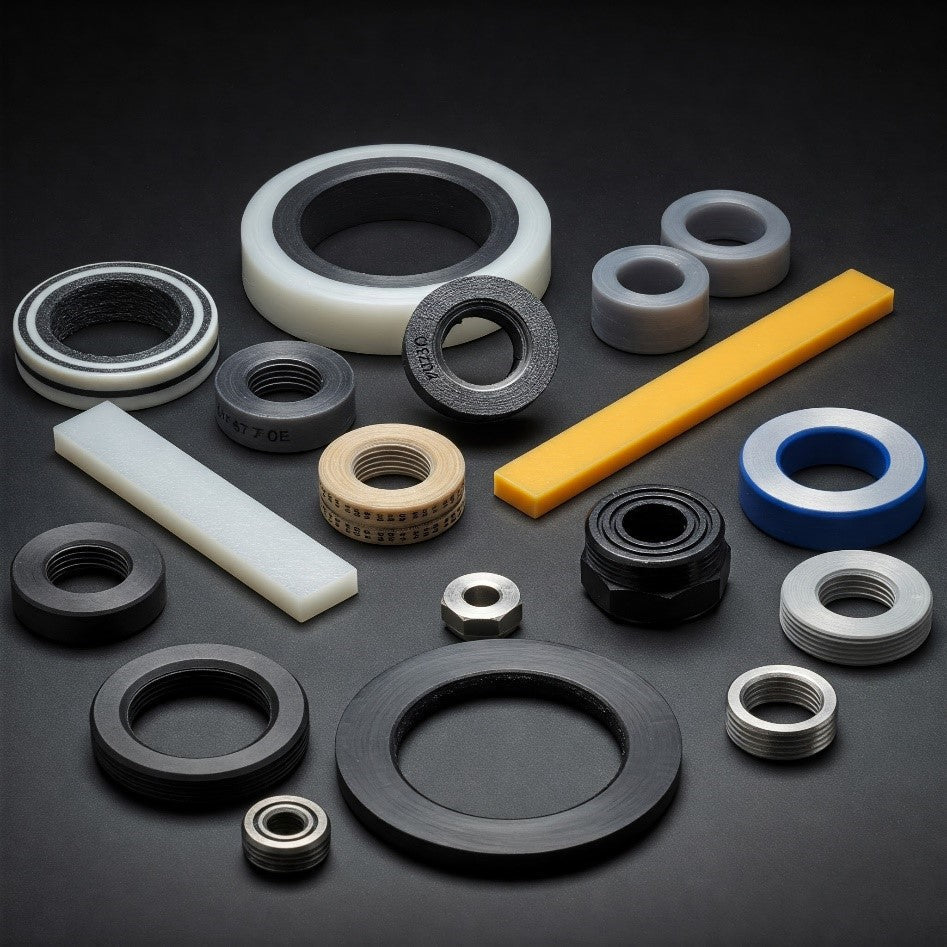Fluid Sealing Materials

Grindmel´s Engineering Team
We are a Honduran company founded by mechanical and electrical engineers.
CONTENT

What are fluid sealing materials, and why are they crucial to the industry??
In any industrial system that handles fluids, whether liquids, gases, or vapors, proper sealing is essential. Sealing materials in fluid handling systems play a critical role in ensuring containment of the process medium, preventing leaks that could compromise operational safety, energy efficiency, and the functional integrity of the equipment.
Its application covers highly regulated industries such as the food and pharmaceutical industries, as well as industries in the mining, energy, and construction sectors, where operating conditions are demanding. A well-designed sealing system not only ensures regulatory compliance and operational continuity, but also significantly reduces the costs associated with corrective maintenance and unscheduled downtime.
In this blog, we'll explore what these materials are, where they're used, and why their proper selection can make the difference between operational efficiency and costly disruptions.
What is fluid sealing?
Fluid sealing is the process of containing or controlling the flow of fluids within a system by using components specifically designed to block, isolate, or direct the flow. These components, known as seals, are installed at critical points where there are joints or movement between parts, such as pumps, valves, pipes, or compressors.
There are different types of seals depending on their application and relative movement of the surfaces involved:
- Static seals: These are used in joints between fixed parts, such as flanges or equipment covers. They are economical and easy to install. Examples: O-rings or flat gaskets.
- Dynamic seals: These operate between moving parts (such as rotating shafts or pistons). They require materials that are more resistant to wear and friction.
- Mechanical seals: These combine static and dynamic elements. Mainly used in rotary pumps, they are more complex and expensive, but offer excellent performance at high pressures and speeds.
- Inflatable and special seals: Used in critical applications, they offer temporary sealing or in extreme conditions (nuclear, food industries, etc.).

Failure of these seals can result in pressure losses, product contamination, or even unwanted production downtime.
What materials are used for fluid sealing?
The selection of the appropriate material depends on the type of fluid, temperature, pressure, and system conditions. Below are some of the most commonly used materials:
NBR (Nitrile)
- Ideal for oils, fats, fuels.
- Temperature: -35°C to 120°C.
EPDM (Ethylene Propylene Diene Monomer)
- Resistant to water, steam, diluted acids.
- Not suitable for oils.
- Temperature: -50°C to 150°C.
FKM (Viton)
- Excellent chemical and high temperature resistance.
- Ideal for aggressive chemicals and fuels.
- Temperature: -20°C to 200°C.
PTFE (Teflon)
- Chemically inert, high thermal resistance.
- It is used in chemical and pharmaceutical processes.
- Temperature: -160°C to 260°C.
Expanded graphite
- Excellent resistance to high temperatures and pressure.
- Widely used in steam valves and flanges.
- Temperature: up to 500 °C or more.
Silicone
- Used in food and pharmaceutical applications.
- Very good elasticity and good chemical resistance
- Temperature: -60°C to 205°C.
Neoprene
- Used in low pressure and water applications.
- Lower chemical resistance compared to other elastomers.
- Temperature: -25°C to 100°C.
The colors shown in this image are for illustrative purposes only. Sealing materials (such as NBR, EPDM, FKM, PTFE, among others) may come in different colors depending on the manufacturer or formulation grade. Therefore, color should not be used as the sole identification criterion. Material verification must be performed using the technical data sheet or certified markings .
Each material has its advantages and limitations. Therefore, there is no one-size-fits-all solution for all applications. For more information on the chemical and thermal compatibility of sealing materials, please visit the following link: https://storage.doitsquare.com/files/166/14ed5ffc-5b67-418f-b594-5da40f0f7fca/chemical-compatibility-table_2023-11-29-14-25-09.pdf
Factors for choosing the right material
Selecting the right sealing material is essential to ensuring system efficiency. Here are some key factors to consider:
- Operating temperature: The temperature of the fluid being handled must be considered. Each material withstands different pressure ranges.
- Operating pressure: A high-pressure system requires materials that are more resistant to deformation since the mechanical stress on the seal is much greater.
- Chemical compatibility: Not all materials are resistant to the same process fluids. The wrong material can degrade rapidly.
- Application Type: Dynamic seals require materials with good wear and friction resistance.
- Regulations: Some applications, such as food or pharmaceuticals, require materials approved by regulations such as FDA or USP.
Conclusion
Fluid sealing materials are essential for safety, efficiency, and sustainability in multiple industries. Their proper selection, installation, and maintenance prevent operational losses and ensure business continuity. New technologies driven by the new industry are also transforming this field, offering smarter solutions that are adaptable to modern demands. Do you need personalized advice or more information about sealing solutions? Contact us and our team of experts will be happy to help you!



